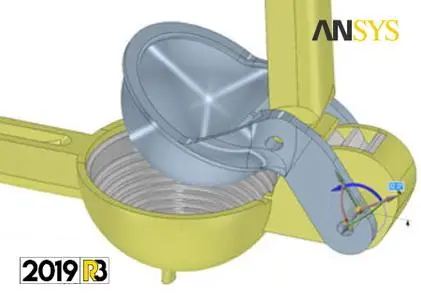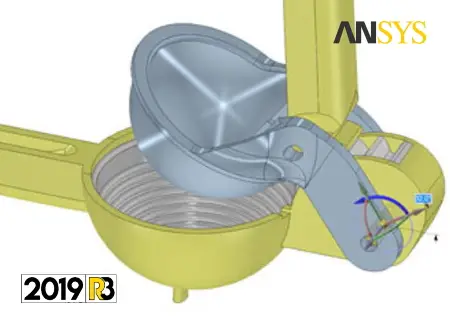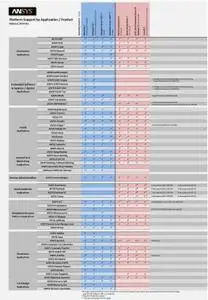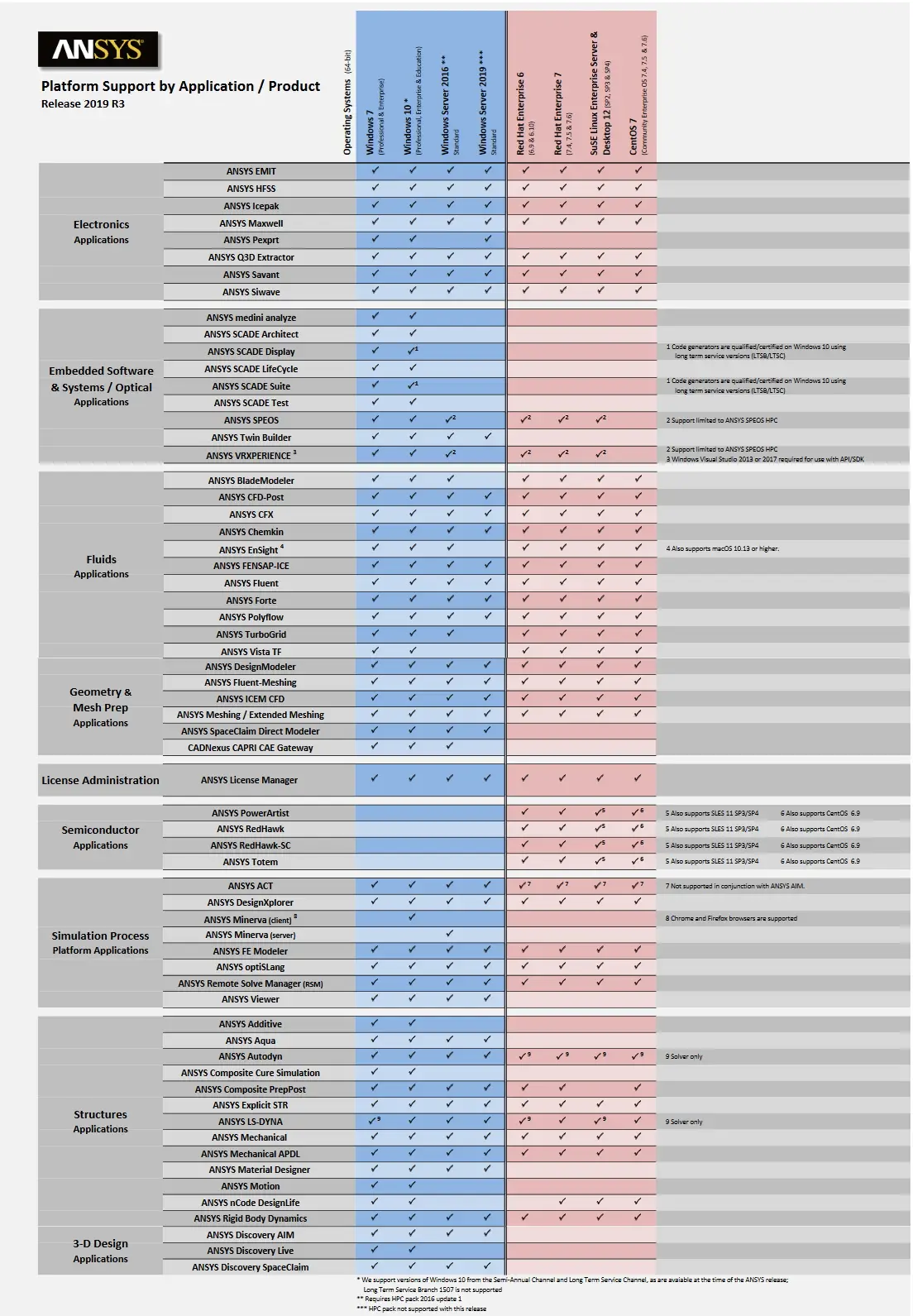ANSYS Products 2019 R3 Linux | 15.6 Gb
The Ansys product team is pleased to announce the availability of Ansys Products 2019 R3, is offers a comprehensive software suite that spans the entire range of physics, providing access to virtually any field of engineering simulation that a design process requires.
ANSYS 2019 R3: Introducing Motion
ANSYS Motion is a third-generation engineering solution based on an advanced multibody dynamics solver. It enables fast and accurate analysis of rigid and flexible bodies and gives accurate evaluation of physical events through the analysis of the mechanical system as a whole.
ANSYS Motion uses four tightly integrated solving schemes: rigid body, flexible body, modal and meshfree EasyFlex. This gives you unparalleled capabilities to analyze systems and mechanisms in any combination you want. Large assemblies with many millions of degrees of freedom can be studied with the effects of flexibility and contact included. Standard connections and joints then allow these systems to be connected and loaded.
In addition to the basic package, ANSYS Motion offers additional toolkits so users working in areas with specific multibody dynamic needs can work faster and more efficiently.
ANSYS 2019 R3: SPEOS Update
ANSYS 2019 R3 has SPEOS innovations that make you see optical simulation in a new light. The following are some details of these innovations:
- SPEOS Live Preview has been enhanced for more flexibility and easier interactivity. You can switch in one click between true and false color, adjust scale adaption to fit with the resulting preview, change the sensor to be previewed and more.
- SPEOS extends optical simulation into the ANSYS multiphysics platform. Meshed geometry is now compatible with body selection, making it possible to export the mesh data from the ANSYS multiphysics platform into ANSYS SPEOS to keep the same mesh definition throughout the complete multiphysics workflow.
- New sensor capabilities in SPEOS enable you to simulate the rotating lidar, a new ambient source U.S. standard atmosphere 1976 and thermal sources on infrared.
- SPEOS enhances your driving experience with cutting-edge features specifically dedicated to head-up display (HUD) development.
- The materials library in SPEOS contains a new library called Road Library for Sensors Simulation.
ANSYS 2019 R3: Introducing SCADE Vision
Because driving environments are increasingly complex, the cost of validating autonomous vehicle (AV) systems is skyrocketing. The future of AVs may depend on which grows faster: market size or validation costs. The industry needs a solution to break the “drive-find-fix” barrier for autonomous systems.
From a safety perspective, complexity is about how many edge cases AV perception systems may encounter. An edge case is a situation — unforeseen in the design phase — that can result in operational failure … or worse.
Newest addition to ANSYS embedded software family: ANSYS SCADE Vision. SCADE Vision speeds up the discovery of edge case-related vulnerabilities in your AV perception software. It helps identify the root causes/triggering events underlying detection failure, by automatically applying augmentations to your input sensor data.
You will discover:
- Why edge cases are so important and why manual methods of identification aren’t efficient
- How SCADE Vision can automatically identify potential vulnerabilities and their root causes in autonomous perception systems
- How SCADE Vision aids in the reporting of safety analysis results to relevant stakeholders and helps create a virtual feedback loop for safety improvements
ANSYS 2019 R3: Additive Manufacturing Update
The latest release of ANSYS additive manufacturing (AM) software includes these new features, among others:
- ANSYS Additive Prep has a new build processor which allows you to export a build file directly to an AM machine.
- ANSYS Workbench Additive enables you to switch easily between viewing the STL supports, mesh or element densities. It also features an option to remove STL supports after cooldown on the AM process sequencer.
ANSYS Additive Print also has multiple new features with regards to supports:
- Support-only cutoff enables you to cut the support from the part but leaves the part attached to the baseplate under the displacement after cutoff output option.
- The Support Groups feature enables multiple supports in a single simulation, including a mix of volume-less and solid support types.
ANSYS 2019 R3: Mechanical Update
New capabilities in Mechanical in this release include:
- Inverse analysis, sometimes referred to as hot-to-cold analysis
- New analysis systems utilizing coupled field elements
- Greater control over user preferences in the Mechanical interface
- Updates to the topology optimization capabilities
ANSYS 2019 R3: Fluent ROMs Update
ANSYS Fluent Quickly and Easily Evaluates ROMs to Explore Design Alternatives
ANSYS Fluent now quickly and easily evaluates very complex reduced-order models (ROMs) to explore design alternatives. For a cross flow heat exchanger, the ROM capability provides a solution for each design point in as little as one second versus over two hours for a full simulation. Learn how ROMs may be post-processed and evaluated in Fluent to gain insight far beyond the numerical output previously available — for example, to compute derived quantities, create plots along surfaces and more
ANSYS 2019 R3: Discovery SpaceClaim Update
This release added new enhancements for designers in ANSYS Discovery SpaceClaim, including automatic skinning to convert faceted geometry into “watertight” models for reverse engineering and generative design.
ANSYS 2019 R3: Fluids Update
Fluids simulation users will find that ANSYS 2019 R3 includes many enhancements that further simplify the user experience and broaden use to new applications. The new Fluent experience has been improved so you can enjoy more CFD in less time, with less training.
- Enhancements include efficient Mosaic-enabled meshes to run parametric studies in ANSYS Workbench, and fault tolerant meshing to support non-conformal interfaces for CHT. The expressions language has been extended to more applications.
- An automated workflow speeds the ANSYS Fluent adjoint solver so you can easily find the optimal shape for given operating conditions.
- Fluent now quickly and easily evaluates complex reduced-order models to explore design alternatives.
- ANSYS Forte can couple with Fluent or ANSYS Mechanical for accurate conjugate heat transfer.
ANSYS 2019 R3: Discovery Live and Discovery AIM Update
Find out how to unlock generative design capabilities in ANSYS Discovery Live — the first interactive topology optimization tool to deliver groundbreaking speed to help you find optimal designs in minutes. Last release will walk you through additional simulation functionality, including mass flow outlets and time-varying inputs. Also added advanced physics updates in ANSYS Discovery AIM, including structural beams support, physics-aware meshing enhancements and linear buckling capabilities.
ANSYS 2019 R3: Introducing DCS
ANSYS Distributed Compute Services (DCS) is a family of applications that allows you to efficiently and robustly distribute, manage and solve simulations across a heterogeneous variety of compute resources. It includes a Design Point Service (DPS) to help you manage (run, filter, sort and compare) tens of thousands of design points spread across clusters, networks and operating systems. It can even break up a project so that parts of it (such as geometry creation) can be handled on resources best suited for it while other parts (such as the solver runs) can be handled on hardware best suited for those sorts of tasks. DCS can help you get the most out of your available compute resources, and then DPS can help you sort through the results to find the best designs.
ANSYS 2019 R3: VRXPERIENCE HMI Update
New features of ANSYS VRXPERIENCE HMI in ANSYS 2019 R3: added application programming interface (API) for establishing a lease line connection to the human–machine interface (HMI). The API facilitates running and interacting with your embedded software in virtual reality (VR) or software-in-the-loop (SIL) systems. It offers out-of-the-box compatibility with ANSYS SCADE and ANSYS SCADE Display. At the same time, the API enables cosimulation with different flight simulators. You can assess the usability and workflows of your HMI under specific flight conditions — to safely test emergency situations with full-cockpit interactivity and validate the HMI from the pilot’s perspective.
VRXPERIENCE HMI also offers new capabilities to prepare a virtual mock-up of the user experience. You can now extract and merge surfaces for selecting geometry sub-elements at lower levels, split surface elements into smaller elements, remove surface elements from a geometry and apply different materials or light on sub-elements. It facilitates the data preparation of material, lighting and HMI actuators, and accelerates the CAD preparation workflow.
ANSYS Motion is a third-generation engineering solution based on an advanced multibody dynamics solver. It enables fast and accurate analysis of rigid and flexible bodies and gives accurate evaluation of physical events through the analysis of the mechanical system as a whole.
ANSYS Motion uses four tightly integrated solving schemes: rigid body, flexible body, modal and meshfree EasyFlex. This gives you unparalleled capabilities to analyze systems and mechanisms in any combination you want. Large assemblies with many millions of degrees of freedom can be studied with the effects of flexibility and contact included. Standard connections and joints then allow these systems to be connected and loaded.
In addition to the basic package, ANSYS Motion offers additional toolkits so users working in areas with specific multibody dynamic needs can work faster and more efficiently.
ANSYS 2019 R3: SPEOS Update
ANSYS 2019 R3 has SPEOS innovations that make you see optical simulation in a new light. The following are some details of these innovations:
- SPEOS Live Preview has been enhanced for more flexibility and easier interactivity. You can switch in one click between true and false color, adjust scale adaption to fit with the resulting preview, change the sensor to be previewed and more.
- SPEOS extends optical simulation into the ANSYS multiphysics platform. Meshed geometry is now compatible with body selection, making it possible to export the mesh data from the ANSYS multiphysics platform into ANSYS SPEOS to keep the same mesh definition throughout the complete multiphysics workflow.
- New sensor capabilities in SPEOS enable you to simulate the rotating lidar, a new ambient source U.S. standard atmosphere 1976 and thermal sources on infrared.
- SPEOS enhances your driving experience with cutting-edge features specifically dedicated to head-up display (HUD) development.
- The materials library in SPEOS contains a new library called Road Library for Sensors Simulation.
ANSYS 2019 R3: Introducing SCADE Vision
Because driving environments are increasingly complex, the cost of validating autonomous vehicle (AV) systems is skyrocketing. The future of AVs may depend on which grows faster: market size or validation costs. The industry needs a solution to break the “drive-find-fix” barrier for autonomous systems.
From a safety perspective, complexity is about how many edge cases AV perception systems may encounter. An edge case is a situation — unforeseen in the design phase — that can result in operational failure … or worse.
Newest addition to ANSYS embedded software family: ANSYS SCADE Vision. SCADE Vision speeds up the discovery of edge case-related vulnerabilities in your AV perception software. It helps identify the root causes/triggering events underlying detection failure, by automatically applying augmentations to your input sensor data.
You will discover:
- Why edge cases are so important and why manual methods of identification aren’t efficient
- How SCADE Vision can automatically identify potential vulnerabilities and their root causes in autonomous perception systems
- How SCADE Vision aids in the reporting of safety analysis results to relevant stakeholders and helps create a virtual feedback loop for safety improvements
ANSYS 2019 R3: Additive Manufacturing Update
The latest release of ANSYS additive manufacturing (AM) software includes these new features, among others:
- ANSYS Additive Prep has a new build processor which allows you to export a build file directly to an AM machine.
- ANSYS Workbench Additive enables you to switch easily between viewing the STL supports, mesh or element densities. It also features an option to remove STL supports after cooldown on the AM process sequencer.
ANSYS Additive Print also has multiple new features with regards to supports:
- Support-only cutoff enables you to cut the support from the part but leaves the part attached to the baseplate under the displacement after cutoff output option.
- The Support Groups feature enables multiple supports in a single simulation, including a mix of volume-less and solid support types.
ANSYS 2019 R3: Mechanical Update
New capabilities in Mechanical in this release include:
- Inverse analysis, sometimes referred to as hot-to-cold analysis
- New analysis systems utilizing coupled field elements
- Greater control over user preferences in the Mechanical interface
- Updates to the topology optimization capabilities
ANSYS 2019 R3: Fluent ROMs Update
ANSYS Fluent Quickly and Easily Evaluates ROMs to Explore Design Alternatives
ANSYS Fluent now quickly and easily evaluates very complex reduced-order models (ROMs) to explore design alternatives. For a cross flow heat exchanger, the ROM capability provides a solution for each design point in as little as one second versus over two hours for a full simulation. Learn how ROMs may be post-processed and evaluated in Fluent to gain insight far beyond the numerical output previously available — for example, to compute derived quantities, create plots along surfaces and more
ANSYS 2019 R3: Discovery SpaceClaim Update
This release added new enhancements for designers in ANSYS Discovery SpaceClaim, including automatic skinning to convert faceted geometry into “watertight” models for reverse engineering and generative design.
ANSYS 2019 R3: Fluids Update
Fluids simulation users will find that ANSYS 2019 R3 includes many enhancements that further simplify the user experience and broaden use to new applications. The new Fluent experience has been improved so you can enjoy more CFD in less time, with less training.
- Enhancements include efficient Mosaic-enabled meshes to run parametric studies in ANSYS Workbench, and fault tolerant meshing to support non-conformal interfaces for CHT. The expressions language has been extended to more applications.
- An automated workflow speeds the ANSYS Fluent adjoint solver so you can easily find the optimal shape for given operating conditions.
- Fluent now quickly and easily evaluates complex reduced-order models to explore design alternatives.
- ANSYS Forte can couple with Fluent or ANSYS Mechanical for accurate conjugate heat transfer.
ANSYS 2019 R3: Discovery Live and Discovery AIM Update
Find out how to unlock generative design capabilities in ANSYS Discovery Live — the first interactive topology optimization tool to deliver groundbreaking speed to help you find optimal designs in minutes. Last release will walk you through additional simulation functionality, including mass flow outlets and time-varying inputs. Also added advanced physics updates in ANSYS Discovery AIM, including structural beams support, physics-aware meshing enhancements and linear buckling capabilities.
ANSYS 2019 R3: Introducing DCS
ANSYS Distributed Compute Services (DCS) is a family of applications that allows you to efficiently and robustly distribute, manage and solve simulations across a heterogeneous variety of compute resources. It includes a Design Point Service (DPS) to help you manage (run, filter, sort and compare) tens of thousands of design points spread across clusters, networks and operating systems. It can even break up a project so that parts of it (such as geometry creation) can be handled on resources best suited for it while other parts (such as the solver runs) can be handled on hardware best suited for those sorts of tasks. DCS can help you get the most out of your available compute resources, and then DPS can help you sort through the results to find the best designs.
ANSYS 2019 R3: VRXPERIENCE HMI Update
New features of ANSYS VRXPERIENCE HMI in ANSYS 2019 R3: added application programming interface (API) for establishing a lease line connection to the human–machine interface (HMI). The API facilitates running and interacting with your embedded software in virtual reality (VR) or software-in-the-loop (SIL) systems. It offers out-of-the-box compatibility with ANSYS SCADE and ANSYS SCADE Display. At the same time, the API enables cosimulation with different flight simulators. You can assess the usability and workflows of your HMI under specific flight conditions — to safely test emergency situations with full-cockpit interactivity and validate the HMI from the pilot’s perspective.
VRXPERIENCE HMI also offers new capabilities to prepare a virtual mock-up of the user experience. You can now extract and merge surfaces for selecting geometry sub-elements at lower levels, split surface elements into smaller elements, remove surface elements from a geometry and apply different materials or light on sub-elements. It facilitates the data preparation of material, lighting and HMI actuators, and accelerates the CAD preparation workflow.
Note: For details on all new features and enhancements, refer to the ANSYS_Inc._Release_Notes.pdf available from the ANSYS.Release.2019R3.Docs.iso in this release.
If you’ve ever seen a rocket launch, flown on an airplane, driven a car, used a computer, touched a mobile device, crossed a bridge, or put on wearable technology, chances are you’ve used a product where ANSYS software played a critical role in its creation. ANSYS is the global leader in engineering simulation. We help the world’s most innovative companies deliver radically better products to their customers. By offering the best and broadest portfolio of engineering simulation software, we help them solve the most complex design challenges and engineer products limited only by imagination.
This ANSYS How To video provides a quick tour of the workspace in ANSYS Discovery AIM. Without getting into an actual simulation, it uses a fluid flow template to examine different parts of the workspace environment. It serves as an introduction to other ANSYS Discovery AIM how-to videos.
Note: While this video was produced using release 19.2, the workflow that is shown is also applicable to the 2019 R1 and 2019 R2 releases of ANSYS Discovery AIM.
ANSYS Inc. Founded in 1970, ANSYS employs nearly 3,000 professionals, many of whom are expert M.S. and Ph.D.-level engineers in finite element analysis, computational fluid dynamics, electronics, semiconductors, embedded software and design optimization. Our exceptional staff is passionate about pushing the limits of world-class simulation technology so our customers can turn their design concepts into successful, innovative products faster and at lower cost. As a measure of our success in attaining these goals, ANSYS has been recognized as one of the world's most innovative companies by prestigious publications such as Bloomberg Businessweek and FORTUNE magazines.
Product: ANSYS Products
Version: 2019 R3 (19.5.0.2019072818)
Supported Architectures: x64
Website Home Page : www.ansys.com
Language: multilanguage
System Requirements: PC *
Supported Operating Systems: *
Size: 15.6 Gb
ANSYS, Inc. Release 2019 R3 products are supported on the Linux platforms and operating system levelslisted in the below.
Processor: EM64T/Opteron 64
Operating System:
Red Hat Enterprise Linux 6.9 and 6.10,
Red Hat Enterprise Linux 7.4-7.6,
SUSE Linux Enterprise Server and Desktop 12SP2 and SP3,
CentOS 7.4-7.6
Memory Requirements: You must have a minimum of 8GB of memory to run product installations; 16 or 32GB of memory is recommended.
ANSYS 2019 R3 - Platform Support by Application / Product
Processor: EM64T/Opteron 64
Operating System:
Red Hat Enterprise Linux 6.9 and 6.10,
Red Hat Enterprise Linux 7.4-7.6,
SUSE Linux Enterprise Server and Desktop 12SP2 and SP3,
CentOS 7.4-7.6
Memory Requirements: You must have a minimum of 8GB of memory to run product installations; 16 or 32GB of memory is recommended.
ANSYS 2019 R3 - Platform Support by Application / Product
Please visit my blog
Added by 3% of the overall size of the archive of information for the restoration
No mirrors please
Added by 3% of the overall size of the archive of information for the restoration
No mirrors please







